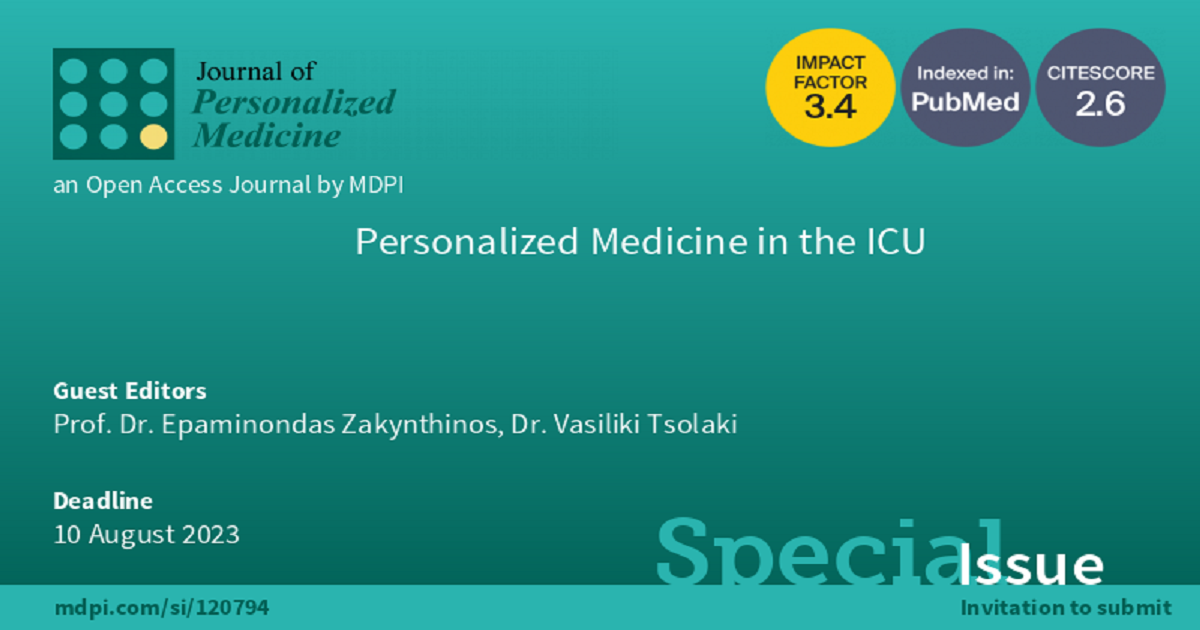Personalized Medicine in the ICU
A special issue of Journal of Personalized Medicine (ISSN 2075-4426). This special issue belongs to the section "Personalized Medical Care".
Deadline for manuscript submissions: closed (10 August 2023) | Viewed by 24548

Special Issue Editors
Interests: critical care; ARDS; mechanical ventilation; sepsis; hemodynamics; echocardiography; arrythmias; cardiomyopathy; neuromonitoring; MODS; COVID-19
Special Issues, Collections and Topics in MDPI journals
Interests: ARDS; mechanical ventilation; sepsis; hemodynamics; echocardiography; respiratory muscles; diaphragm; esophageal pressure; neuromonitoring; COVID-19
Special Issues, Collections and Topics in MDPI journals
Special Issue Information
Dear Colleagues,
The Journal of Personalized Medicine has launched a Special Issue on “Personalized medicine in the ICU”.
Critical Care Medicine has been dealing with the most vulnerable patient—the critically ill. Pathophysiologic mechanisms of disease and response to disease, monitoring issues and individualized treatment approaches, especially concerning the dosing, are distinct compared to regular patients and vary considerably between critical care patients. Critical Care Departments hospitalize patients with a wide diversity of diseases requiring different management approaches (neurosurgical, thoracic-surgical, general surgical, medical, COVID-19 patients).
More than ever, in the pandemic era, scientists have realized the rationale to personalize medicine, especially for critically ill patients. Clinicians have dealt with patients presenting one disease (COVID-19), but with diversity in clinical, laboratory and pathophysiological findings. This wide variance highlighted the need to identify subpopulations and tailor the treatment applied. Multiple subphenotypes have been identified concerning the presence of ARDS, sepsis, hyperinflammatory syndrome or multiorgan involvement. The pandemic clarified that although there was a huge number of patients suffering from the same disease modality, many randomized controlled trials failed to simplify the therapeutic approach. The underlying different pathophysiologic, cellular and molecular pathways called for individualization of treatments. The “one size does not fit all” approach is translated into precision medicine.
Under this perspective, we are calling for review articles and original contributions covering all aspects of how personalized medicine can improve critically ill patients’ management in the ICU.
Prof. Dr. Epaminondas Zakynthinos
Dr. Vasiliki Tsolaki
Guest Editors
Manuscript Submission Information
Manuscripts should be submitted online at www.mdpi.com by registering and logging in to this website. Once you are registered, click here to go to the submission form. Manuscripts can be submitted until the deadline. All submissions that pass pre-check are peer-reviewed. Accepted papers will be published continuously in the journal (as soon as accepted) and will be listed together on the special issue website. Research articles, review articles as well as short communications are invited. For planned papers, a title and short abstract (about 100 words) can be sent to the Editorial Office for announcement on this website.
Submitted manuscripts should not have been published previously, nor be under consideration for publication elsewhere (except conference proceedings papers). All manuscripts are thoroughly refereed through a single-blind peer-review process. A guide for authors and other relevant information for submission of manuscripts is available on the Instructions for Authors page. Journal of Personalized Medicine is an international peer-reviewed open access monthly journal published by MDPI.
Please visit the Instructions for Authors page before submitting a manuscript. The Article Processing Charge (APC) for publication in this open access journal is 2600 CHF (Swiss Francs). Submitted papers should be well formatted and use good English. Authors may use MDPI's English editing service prior to publication or during author revisions.
Keywords
- ARDS
- mechanical ventilation
- respiratory mechanics
- monitoring
- ultrasonography
- respiratory muscles
- diaphragm
- cardiomyopathy
- arrhythmias
- sepsis
- blood stream infections
- antimicrobial resistance
- ventilator-associated pneumonia
- neuromonitoring
- MODS
- COVID-19
Benefits of Publishing in a Special Issue
- Ease of navigation: Grouping papers by topic helps scholars navigate broad scope journals more efficiently.
- Greater discoverability: Special Issues support the reach and impact of scientific research. Articles in Special Issues are more discoverable and cited more frequently.
- Expansion of research network: Special Issues facilitate connections among authors, fostering scientific collaborations.
- External promotion: Articles in Special Issues are often promoted through the journal's social media, increasing their visibility.
- Reprint: MDPI Books provides the opportunity to republish successful Special Issues in book format, both online and in print.
Further information on MDPI's Special Issue policies can be found here.






